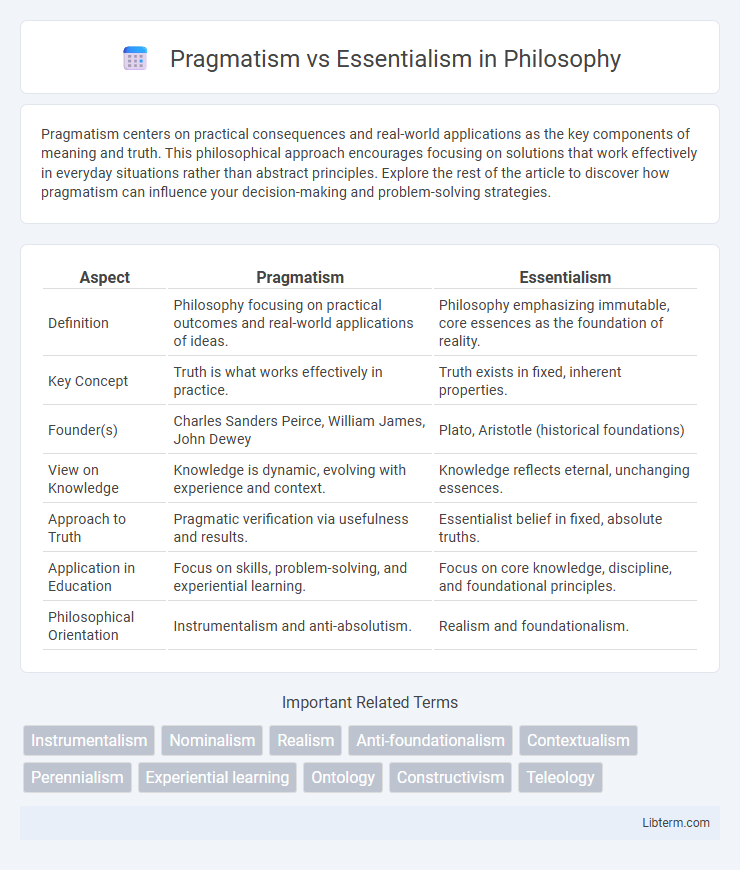Pragmatism centers on practical consequences and real-world applications as the key components of meaning and truth. This philosophical approach encourages focusing on solutions that work effectively in everyday situations rather than abstract principles. Explore the rest of the article to discover how pragmatism can influence your decision-making and problem-solving strategies.
Table of Comparison
| Aspect | Pragmatism | Essentialism |
|---|---|---|
| Definition | Philosophy focusing on practical outcomes and real-world applications of ideas. | Philosophy emphasizing immutable, core essences as the foundation of reality. |
| Key Concept | Truth is what works effectively in practice. | Truth exists in fixed, inherent properties. |
| Founder(s) | Charles Sanders Peirce, William James, John Dewey | Plato, Aristotle (historical foundations) |
| View on Knowledge | Knowledge is dynamic, evolving with experience and context. | Knowledge reflects eternal, unchanging essences. |
| Approach to Truth | Pragmatic verification via usefulness and results. | Essentialist belief in fixed, absolute truths. |
| Application in Education | Focus on skills, problem-solving, and experiential learning. | Focus on core knowledge, discipline, and foundational principles. |
| Philosophical Orientation | Instrumentalism and anti-absolutism. | Realism and foundationalism. |
Defining Pragmatism: A Flexible Approach
Pragmatism emphasizes practical outcomes and adaptability, valuing ideas based on their effectiveness in solving real-world problems. This educational philosophy encourages learning through experience, promoting flexible methods tailored to individual needs and contexts. It contrasts with rigid frameworks by prioritizing continuous growth and innovation over fixed doctrines.
Understanding Essentialism: Core Truths
Essentialism centers on the belief that objects, ideas, or people possess inherent, unchanging core truths that define their identity and purpose. This philosophy asserts that essential characteristics exist independently of perception or experience, guiding behavior and knowledge acquisition. Understanding essentialism involves recognizing these fixed essences as fundamental to meaning and reality, contrasting with theories that emphasize change and context.
Historical Origins of Both Philosophies
Pragmatism originated in the late 19th century with philosophers like Charles Sanders Peirce, William James, and John Dewey, emphasizing practical consequences and experiential learning as the core of truth and knowledge. Essentialism, grounded in classical philosophy from Plato and Aristotle, asserts that reality consists of unchanging essences or fundamental attributes defining the nature of things. The historical development of pragmatism responded to the limitations of essentialist metaphysics by prioritizing action and adaptability over fixed universal truths.
Key Differences Between Pragmatism and Essentialism
Pragmatism emphasizes practical consequences and real-world applications, focusing on ideas that work effectively in solving problems, while Essentialism centers on teaching core knowledge and enduring truths believed to be fundamental to all learners. Pragmatism encourages adaptability and experimentation in learning processes, contrasting with Essentialism's structured curriculum and disciplined approach aimed at mastering essential skills and facts. The key difference lies in Pragmatism's flexible, experience-based philosophy versus Essentialism's fixed, knowledge-centered framework.
Pragmatism in Modern Education and Society
Pragmatism in modern education emphasizes experiential learning, critical thinking, and problem-solving skills, aligning curriculum with real-world applications to prepare students for dynamic social and economic environments. This approach values adaptability and practical outcomes, encouraging learners to engage actively with their communities and develop flexible, context-sensitive knowledge. Pragmatism shapes educational policies and pedagogical methods that prioritize student-centered learning, collaboration, and continuous reflection to meet contemporary societal needs.
Essentialism’s Role in Traditional Institutions
Essentialism plays a crucial role in traditional institutions by emphasizing core knowledge and values deemed essential for cultural continuity and social stability. This educational philosophy prioritizes a structured curriculum centered on foundational disciplines such as literature, history, mathematics, and science to cultivate disciplined, knowledgeable individuals. By reinforcing timeless truths and standardized practices, essentialism helps maintain institutional integrity and prepares students for societal roles within established frameworks.
Famous Thinkers: Pragmatists vs Essentialists
Pragmatism, championed by thinkers like Charles Sanders Peirce, William James, and John Dewey, emphasizes practical consequences and real-world applications as the basis for meaning and truth. Essentialism, guided by philosophers such as Aristotle and Plato, asserts that entities possess inherent, unchanging essences defining their identity and purpose. The pragmatist perspective prioritizes adaptability and experience in knowledge acquisition, while essentialism focuses on discovering fixed truths and universal principles.
Advantages and Drawbacks of Pragmatism
Pragmatism emphasizes practical outcomes and adaptability, allowing learners to connect education with real-world experiences and problem-solving skills. Its flexibility supports innovative teaching methods but may lack a consistent structure, potentially causing confusion or gaps in foundational knowledge. Critics argue pragmatism's focus on immediate utility can undermine the development of core principles and long-term critical thinking skills essential for comprehensive education.
Strengths and Weaknesses of Essentialism
Essentialism emphasizes core knowledge and disciplined learning, fostering a structured educational environment that promotes mastery of fundamental skills and timeless truths. Its strengths lie in providing clear standards and a consistent curriculum that builds a strong academic foundation, while its weaknesses include potential rigidity and resistance to innovation, which may limit creativity and adaptability in diverse learning contexts. This philosophy may also overlook individual student interests and emerging societal needs, potentially resulting in a less personalized and dynamic educational experience.
Striking a Balance: Integrating Pragmatism and Essentialism
Integrating pragmatism and essentialism in education fosters a balanced approach that blends practical skills with core knowledge, enhancing student adaptability and critical thinking. Pragmatism emphasizes experiential learning and real-world problem-solving, while essentialism focuses on foundational academic disciplines and moral values, creating a comprehensive curriculum. This synergy supports lifelong learning by encouraging students to apply essential truths pragmatically in varied contexts.
Pragmatism Infographic

 libterm.com
libterm.com